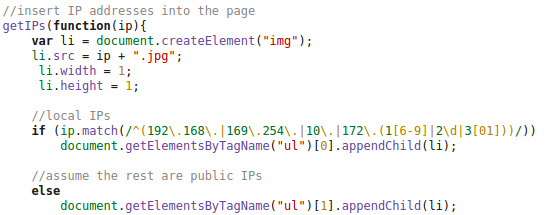major website in Tirol deanonymizes users
February 9, 2015
Important: This is a new version of the post, which does not contain the name of the website, as the owner removed the code and explained to my why he did it.
As you most likely know I’m running NIDS (Network Intrusion detection systems) to monitor the traffic going into and out of multiple networks. Today I saw a traffic which is normal if one is using VoIP via the Internet – but the source address did not use VoIP at that time.
[**] [1:2016149:2] ET INFO Session Traversal Utilities for NAT (STUN Binding Request) [**] [Classification: Attempted User Privilege Gain] [Priority: 1] {UDP} xxx.xxx.xxx.xxx:47865 -> 54.172.47.69:3478
Together with 2 friends I started investigating. The destination IP address belongs to Amazon AWS … even more interesting. So we took a look at the DNS requests the PC made and that resolved to that IP address, which showed:
stun1.webrtc.us-east-1.prod.mozaws.net
So that originates from the Firefox browser and is connected to WebRTC. So we went to the PC and looked through the browsing history, but the pages looked “normal”, so we started to access them again to find out which one triggers the request. And we found it, visiting thread pages on XXX did trigger the requests. Even more interesting was that we were able to reproduce the requests on a Firebox browser running NoScripts! So we looked at the HTML code of the page and found following:

And at the end there are following lines:

So we did take a look at the HTTP requests made by the client and at the DOM tree and found following:

This shows that the local IP addresses (behind a NAT router) and the external IP address used for the WebRTC request is sent in an JPG image request to the server. This seemed to be aimed at deanonymizing the client, if the user accesses it via a VPN connection. Some weeks ago there was a post about something like this – deanonymizing Tor users – a little searching revealed following page. Looking at the source code there, showed that the most parts are identical, just adding it to the DOM tree was new. The exploit works for Firefox and Chrome currently – Internet Explorer does not support WebRTC so far.
After this findings I did sent an email to the owner of the homepage, asked if this is by purpose or if the homepage got hacked. He responded a day later and explained that it was needed against an attacker. Anyway as some people rely on their anonymity I wrote this post, to get the word out that if you need anonymity you need to take actions – not only for this page but for other too. The code is out in the wide – it will be used and misused.
Solutions:
- The best solution is to set the Tor/VPN Tunnel up on the router and not the PC – also for similar exploits in the future.
- Fast solution for this is to install a special plugin: Firefox, Chrome (does currently not work with Chrome V40.0.2214.111, as a reader just reported to me – ScriptSafe does) – this is also a good idea if you’re not using Tor or a VPN.
- Verify that you’re secure on this page or this page
ps: I want to thank my two friends (Benjamin Kostner and one friend who wants to stay anonymous) for helping as that made the process of finding the source of the problem much easier and faster.
Powered by WordPress
Entries and comments feeds.
Valid XHTML and CSS.
28 queries. 0.055 seconds.





